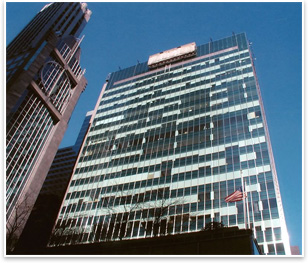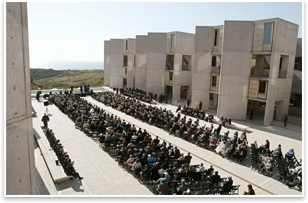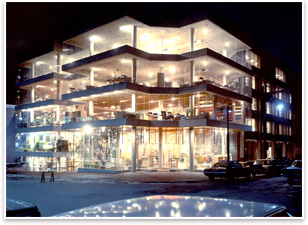
Preserving Modern Architecture in the Postmodern World
At its best, the Modern movement captured a spirit of progress,
openness, and an uplifting of the human condition, offering to convert
lofty civic ideals into physical reality The history gap We must acknowledge history, and that Modernism is a part of history. History, in this case, should be seen as a post-Modern synthesis that combines the Hegelian engine of relentless change with the more contemporary notion that history is not fixed, but that every era subjects history to constant re-interpretation. The theoreticians of the Modern movement embraced the notion of a perpetually forward-looking, linear history of constant progress, whereas today progress is viewed as being relative rather than absolute, and history, rather than being seen as that which is left behind, is instead constantly revisited for the refreshment of ideas. The theoreticians of the Modern movement embraced the notion of a perpetually forward-looking, linear history of constant progress, whereas today progress is viewed as being relative rather than absolute Contemporary design references history in its continued embrace of the aesthetics and technology of Modern architecture, but without the polemic that was inherent in Modernism in its relationship to the entire past history of Western architecture. As DOCOMOMO (the working party for the Documentation and Conservation of the Modern Movement) founder Hubert-Jan Henket points out, this polemic is both technical and aesthetic, but at its essence it is social, driven by a collective desire to create habitats designed with the instruments of modernity to improve human life. This suggests, as we set out to infuse contemporary design into Modern buildings, that it is appropriate to acknowledge the continued meaning of this polemic by considering the social or moral component inherent in any intervention strategy. Preservation’s place If we accept Westfall’s premise that preservation, as it has been defined in documents ranging from the Athens Charter to the U.S. Secretary of the Interior’s Standards, is itself a part of the Modernist project, then we should also recognize that preservation must now be adapted to the post-Modern present. Preservation can and should be an activist force for change. It should acknowledge and plan for a future that can reflect only a selective, and therefore subjective, view of the past. Preservation strives to elucidate the past through the historical facts embodied in a place, but in fact, the process of intervention will inevitably bring new perception and hence new meaning to the work through the modification of both the work and its context. To this end, a preserved building’s future should be designed with the same intellectual rigor and aesthetic sensitivity that inform any successful, contemporary architectural project. A preserved building’s future should be designed with the same intellectual rigor and aesthetic sensitivity that inform any successful, contemporary architectural project This suggests that the conventional assumption that preservation and design are diametrically opposed is rapidly dissolving. Preservation, as it applies to buildings and urban design, is increasingly recognized as being fully integrated within the practice of architecture, operating out of a theoretical framework that recognizes the inevitability of change. The goal of preservation will increasingly become to create dialogues that heighten the perception of the original, while acknowledging and acting upon this inevitability. This revisionist approach is well articulated by scholars like Jorge Otero-Pailos, the editor of Future Anterior, who views contemporary preservation as an instrument that produces rather than finds history, through the regeneration of context through intervention, rather than a detached reaction to a fixed, stable context. While Otero-Pailos advances a theory of critical historiography that clearly moves beyond Modernism, Vittorio Gregotti describes in Inside Architecture a concept of intervention that reconciles a Modernist theoretical position with the principle of belonging. This concept embodies “interest in the materials of memory, not nostalgically, but in terms of juxtaposition . . . forming new orders and groupings by shifting the context of those materials that belong to memory’s heritage.”
Preservation and Modernism We acknowledge that there is a necessary human dimension found in traditional urban form and place-making that is lacking in a lot of OEM. This situation should be viewed as an opportunity to mine the artifacts for latent meaning through a process of critical discovery meant to transform and “re-humanize” the original. This resembles the strategy that has been adopted by the U.S. General Services Administration in the “First Impressions” part of its Design Excellence program that is creating sensitive contemporary interventions within the large body of OEM owned by the federal government. In this case, the quality of the original architecture may be augmented through using the existing buildings as structural armatures upon which to build new experiences, introducing elements of scale and texture that will reinvigorate and make contemporary (one can’t really say “modernize”) works that might otherwise seem to have exhausted their useful lives. This strategy runs counter to the notion of “total design” and recognizes that design is often most successful focusing on solving small problems and local issues. Compensation for these shortcomings are made with contemporary elements in line with a UNESCO statement that: “. . . preservation . . . [should avoid] all forms of pseudo-historical design, as [it] constitutes a denial of both the historical and the contemporary alike . . . history must remain readable, while continuity of culture through quality interventions is the ultimate goal.”
Engaging the Modern movement often means dealing with structures designed with finite life spans and with materials that were not designed to age well The argument is sometimes made that the aesthetic and technical distinctions between the works of Modernism and much of the significant output of contemporary architecture is sufficiently blurred that we may ourselves still be defined as late Modernists. As such, on one level, we can treat modifications to High Modernism as works that can still build upon the form and spirit of the original, but we must nonetheless acknowledge that Modernism’s own history was finite, that we are now in a different place philosophically, and that the temporal gap between the original and the intervention—however much the latter may seem to extend the former—should be acknowledged. As preservationists, our response to the original Modernist idea can be through extension or through the emphasis of difference. The important thing is that the act of intervention is clearly acknowledged as a starting point for an architectural dialogue. The process then becomes one of weaving the modifications into the original in such a way that a continuum is created that both reveals the past and leaves open possibilities for the future. As we engage the works of the Modern movement as preservationists, so we also advance the transcendent goal of humanizing our environment The urgency of meeting the challenge to preserve the heritage of the Modern movement, and the emerging activist, critical approach to preservation, are inextricably linked. We suggest that this new synthesis—with its notion of a continuum evolving around a set of values about building and accommodating the inevitability of change—actually parallels some of the rhetoric and practice of the traditional building movement, as noted by Westfall. His notion that there is a continuum of building that has been interrupted by the anomaly of Modernism has now in a sense been turned inside out, as we are now dealing with a parallel continuum building upon the Modern tradition that has moved into the post-Modern era. These efforts should all have the ultimate goal of encouraging contemporary intervention in a humanist spirit. As we engage the works of the Modern movement as preservationists, so we also advance the transcendent goal of humanizing our environment, thus preserving and sustaining not just buildings, but a significant part of our collective cultural legacy. |
||
Copyright 2008 The American Institute of Architects. All rights reserved. Home Page |
||
home
thoughts and theory
big buildings
smaller scale
special issues
David N. Fixler, AIA, is a principal with Einhorn Yaffee Prescott, Architecture & Engineering, and president of DOCOMOMO-US/New England.
1. Paul Rudolph’s iconic 1963 Yale Art and Architecture Building, currently is under restoration by Gwathmey Siegel & Associates. Photo © Ezra Stoller/ESTO.
2. Replacement of the curtain wall of Gordon Bunshaft’s 1952 Lever House, New York City, by Skidmore Owings & Merrill LLP, captured a 2003 AIA Honor Award. The building itself received the 1980 AIA Twenty-five Year Award. Photo © SOM, by Ezra Stoller/ESTO Photographics.
3. The 2003 AIA Fellows investiture ceremony was held at the Louis Kahn’s Salk Institute, La Jolla, Calif., the 1992 AIA Twenty-five Year Award recipient. Photo courtesy of the AIA.
4. Benjamin Thompson Associates’ Design Research Headquarters, Cambridge, Mass., recipient of the 2003 AIA Twenty-five Year Award, was adapted to serve as retail space. Photo © Esto Photographics.




